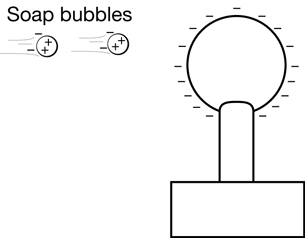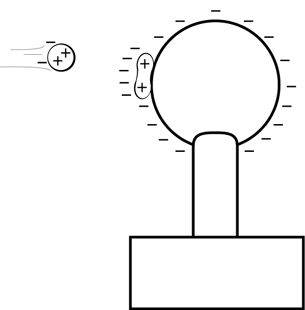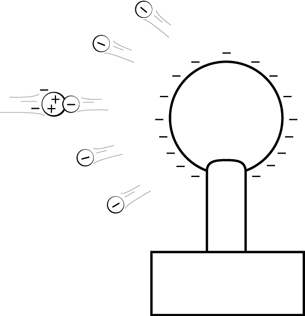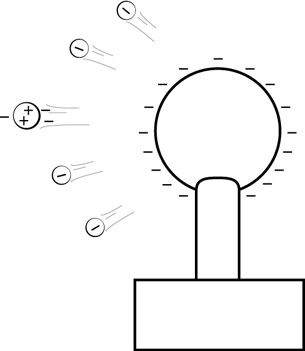Module 3
1. Module 3
1.8. Page 6
Module 3—Electrical Phenomena
 Reflect and Connect
Reflect and Connect
Retrieve the chart of your explanations of what happened using the Van de Graaff generator at the beginning of the lesson. Now that you have explored the three methods of transferring charge, you may need to reconsider your previous explanations.

Before you revise your chart, you need a little background information about the charge on the top of a Van de Graaff generator.
The globe of the Van de Graaff generator becomes negatively charged as excess electrons are transferred from a connection to the ground. This is done as a fast-moving belt rushes by metal combs at the top and bottom of the machine. Since the globe of the Van de Graaff generator is a conductor, the excess electrons redistribute themselves evenly over the surface of the globe. These excess electrons cannot return to the base because the rubber belt and the plastic column supporting the globe are insulators.
It takes work to force electrons to move from the ground connection at the base to the globe at the top. This is why input energy must be supplied by the motor of the generator to rotate the rubber belt on its two pulleys. You’ll learn more about the energy required to do work on moving charges in later lessons.
 Module 3: Lesson 1 Assignment
Module 3: Lesson 1 Assignment
Remember to submit the answers to A 2 and A 3 to your teacher as part of your Module 3: Lesson 1 Assignment.
A 2. As you saw in the opening activity for this lesson, objects were placed on the globe of the Van de Graaff generator.
In each case, electrons were transferred from the negatively charged globe of the Van de Graaff generator to each of these objects. The result was that individual objects became negatively charged.
Use what you have learned in this lesson to explain the behaviour of each of these objects after the Van de Graaff generator was turned on. Submit your revised explanations for each of the following demonstrations to your teacher:
- animal fur
- aluminum pie plates
- confetti
 Try This: Explaining the Behaviour of the Soap Bubbles
Try This: Explaining the Behaviour of the Soap Bubbles
Now that you have improved upon your explanations of the first three Van de Graaff generator demonstrations, reconsider the behaviour of the soap bubbles.

The behaviour of the soap bubbles is much more complex than that of the animal fur, the pie plates, or the confetti because the soap bubbles are subject to a sequence of interconnected events.
These events have been organized into the four steps listed below. In each step, describe what is happening and then explain. You can check your answers by clicking on the Description and Explanation buttons.
Step 1: Neutral soap bubbles are attracted to the negative globe.

For more information, click on Description and Explanation.
A stream of neutral soap bubbles is blown toward the negative globe of the Van de Graaff generator. As the bubbles get closer to the Van de Graaff generator, a charge shift occurs within the soap molecules. The side of the molecules closest to the negative globe becomes positively charged. The closest bubbles are attracted to the negative globe.
This is an example of induction because the electrons within the soap molecules shift due to the presence of the negative globe. Molecules of the soap solution are attracted to the Van de Graaff generator because the positive sides of these molecules are closer to the Van de Graaff generator than the negative sides.
Step 2: The first soap bubble collides with the globe and becomes negatively charged.

For more information, click on Description and Explanation.
This step happens in an instant. Upon contact with the Van de Graaff generator, the soap bubble picks up excess electrons from the Van de Graaff generator. Then the negatively charged soap bubble bursts, sending tiny droplets of negatively charge soap into the air.
This is an example of charging by conduction because electrons are transferred to the molecules of the soap solution as they touch the negatively charged globe.
Step 3: The repelled tiny negative droplets collide with incoming soap bubbles.

For more information, click on Description and Explanation.
The tiny droplets from the burst soap bubble are now repelled from the negatively charged Van de Graaff generator. A spray of negatively charged droplets fills the air around the globe. These negative droplets are attracted to the bubbles’ positive side (see step 1). Some of these droplets collide with incoming bubbles, adding excess electrons to the bubbles, making them negatively charged by conduction.
This is an example of charging by conduction because electrons are transferred to the incoming soap bubbles as they collide with the negatively charged droplets.
Step 4: Incoming bubbles are repelled and move away from the negatively charged globe.

For more information, click on Description and Explanation.
The incoming soap bubble is now negatively charged, so the negatively charged globe repels it.
The incoming negatively charged soap bubble is now pushed away from the negatively charged globe because like charges repel.
 Big Picture Reflection
Big Picture Reflection
Connecting Bubbles and Lightning Strikes
In the previous section you worked at describing and explaining what happens to a soap bubble near the negatively charged globe of a Van de Graaff generator.
You might be surprised to know that the principles explained in this demonstration can also be applied to lightning.
 Read
Read
Carefully read the section called “How Lightning Gets Its Charge” on page 522 of your physics textbook. As you read this section, look for similarities between lightning and the soap bubble demonstration.
 Discuss
Discuss
D 1. Summarize the piece from the textbook called “How Lightning Gets Its Charge” by writing or illustrating a series of steps that will concisely describe and explain what occurs in this process. Your result should be in a format similar to the steps used to describe and explain the soap bubble in the previous activity. Remember to add the answer to this question to your course folder.
D 2. Post your summary to the discussion area set up by your teacher. Compare your summary to at least one other explanation produced by another student. Identify similarities and differences between your work and the work of other students. Remember to add the answer to this question to your course folder.
D 3. If you were to update your explanation of lightning based on what you learned in D 2, what changes would you make? Remember to add the answer to this question to your course folder.
 Module 3: Lesson 1 Assignment
Module 3: Lesson 1 Assignment
Remember to submit the answer to D 4 to your teacher as part of your assignment.
D 4. Use your answers to Discuss questions D 1, D 2, and D 3 to revise your explanation of how lightning gets its charge. Submit your revised summary to your instructor as part of your assignment.
Discussion Scoring Guide
| Principles involved: Static electricity | ||||
Criteria |
Level 1 |
Level 2 |
Level 3 |
Level 4 |
Knowledge |
||||
Demonstrates understanding of the situation, physics principles and technology, and their connections. |
Demonstrates a vague and sometimes incorrect understanding of the physics principles involved. Obvious irrelevant or missing information. |
Demonstrates a basic understanding of the physics principles involved. May exhibit minor mistakes or vague information or application to the situation. |
Demonstrates a good understanding of the physics principles involved and applies them properly to the given situation. All necessary information is given. |
Demonstrates a superior understanding of the physics principles involved and their application to the situation. All applications are considered in detail. |
Reflection |
||||
The post shows reflection on one’s own and other students’ work. Contributes to the group discussion. |
Does not make an effort to participate. Seems indifferent to discussion. |
Occasionally makes meaningful reflections on the group’s efforts or discussions. Marginal effort is shown to become involved with the group or discussion. |
Frequently makes meaningful reflections on the group’s efforts and presents relevant viewpoints for consideration by the group. Interacts freely with group members. |
Regularly attempts to motivate the group discussion and delve deeper into concepts. Interacts freely and encourages all group members. |
Content and presentation of discussion summary |
||||
The information is logically arranged in a clear and concise manner. |
The information is poorly organized with many concepts implied. Irrelevant or rambling sentences make reading difficult. |
The information is somewhat organized with implied concepts. Excessive words or awkward sentences are used, which hinder reading. |
The information is well-organized and logically arranged. All concepts are explicitly explained. There are a few awkward but understandable sentences. |
The information is well- organized and very easy to understand. Well-worded sentences make reading pleasurable. |
 Module 3: Lesson 1 Assignment
Module 3: Lesson 1 Assignment
Remember to submit your Module 3: Lesson 1 Assignment, including question A 4 to your teacher for marks.
A 4. Do question 10 of “10.1 Check and Reflect” on page 523 of your physics textbook.